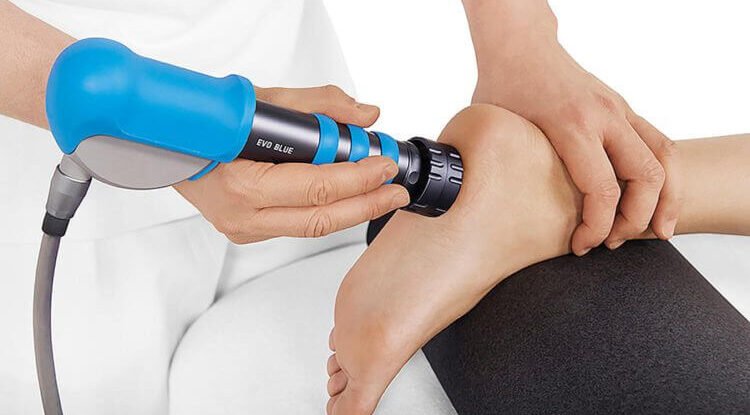13588 88 Ave #202, Surrey, BC V3W 2P5
Welcome to King George Physio!
-
Call for help: (604) 503-5682
-
Welcome to King George Physio!
Call for help: (604) 503-5682

Shock wave therapy in physiotherapy is a modern, non-invasive treatment option used to relieve chronic pain and accelerate healing in muscles, tendons, and joints. Also known as extracorporeal shock wave therapy (ESWT), this technique uses high-energy sound waves to stimulate the body’s natural healing processes.
If you’re dealing with long-term pain that hasn’t responded to traditional physiotherapy, shock wave therapy may offer a solution. Let’s explore how it works and whether it’s right for you.
Shock wave therapy is a treatment technique that delivers acoustic energy (shock waves) to injured tissues to trigger biological responses such as increased blood flow, tissue regeneration, and pain relief. It is most commonly used in physiotherapy for chronic soft tissue injuries and musculoskeletal disorders.
There are two main types:
Radial shock wave therapy (rSWT): More superficial, used for surface-level conditions like tendinitis.
Shock waves are directed through the skin to the injured area using a handheld device. These waves stimulate:
– Cellular regeneration
– Increased circulation
– Breakdown of scar tissue or calcification
– Pain modulation by affecting nerve endings
The process enhances the body’s repair mechanisms, speeding up recovery without the need for medication or surgery.
Shock wave therapy in physiotherapy is often recommended for the following conditions:
– Plantar fasciitis
– Tennis elbow (lateral epicondylitis)
– Calcific shoulder tendinitis
– Achilles tendinopathy
– Shin splints
– Hip bursitis
– Patellar tendinopathy (jumper’s knee)
No needles or incisions are involved, making it ideal for those seeking non-surgical relief.
Many patients experience reduced pain within 1–3 sessions.
Stimulates tissue regeneration and repair, promoting quicker recovery.
Typically well-tolerated with mild discomfort or temporary soreness post-treatment.
By reducing pain and inflammation, patients often regain range of motion and function faster.
Duration: 15–30 minutes
Sensation: You may feel pulses or tapping, sometimes mildly uncomfortable
Post-treatment: Mild swelling or soreness, usually subsides within 24–48 hours
Frequency: Typically 3–5 sessions are needed over several weeks
Shock wave therapy may not be suitable for:
– Pregnant individuals
– Those with blood clotting disorders
– Patients with pacemakers or nerve disorders
– Individuals with infections or open wounds at the treatment site
Consult a physiotherapist to evaluate your eligibility.
Yes. Shock wave therapy is FDA-approved and backed by clinical research. It is widely used by sports physiotherapists, orthopedic specialists, and rehabilitation centers globally. When administered by a trained professional, the risk of complications is minimal.
Numerous studies support the effectiveness of ESWT. For example:
“A 2020 review in the Journal of Orthopaedic Surgery and Research found that ESWT significantly improved pain and function in patients with chronic tendinopathies.”
Evidence continues to grow supporting its use in sports rehab, post-injury recovery, and chronic pain management.
Shock wave therapy in physiotherapy is revolutionizing how we treat chronic pain and soft tissue injuries. With minimal risks and proven outcomes, it offers a compelling option for patients seeking faster, non-invasive recovery.
Whether you’re an athlete, dealing with repetitive stress injuries, or struggling with long-term tendon pain, consult a licensed physiotherapist to see if ESWT is a suitable option for your condition.
Many patients report improvement after 1–2 sessions, with full benefits typically seen after 3–5 treatments.
Mild discomfort may occur during the session, but it’s tolerable and temporary.
It varies by provider and condition. Some insurance plans may cover it if deemed medically necessary.
Many patients report improvement after 1–2 sessions, with full benefits typically seen after 3–5 treatments.
Mild discomfort may occur during the session, but it’s tolerable and temporary.
It varies by provider and condition. Some insurance plans may cover it if deemed medically necessary.